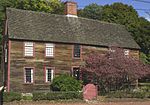Highland School (Winthrop, Massachusetts)
1921 establishments in MassachusettsBuildings and structures in Suffolk County, MassachusettsNational Register of Historic Places in Suffolk County, MassachusettsNeoclassical architecture in MassachusettsSchool buildings completed in 1921 ... and 3 more
School buildings on the National Register of Historic Places in MassachusettsSuffolk County, Massachusetts Registered Historic Place stubsWinthrop, Massachusetts

The Highland School, also the Arthur W. Dalrymple School, is a historic school building at 36 Grovers Avenue in Winthrop, Massachusetts. The Georgian Revival two story brick building was built in 1920–21 to replace a nearby school that burned down in 1920. It was built on the site of the Leighton Resort, a popular summer destination. The school's later dedicatee was a local resident who taught at the school and later became Winthrop's superintendent of schools.The building was added to the National Register of Historic Places in 2014.
Excerpt from the Wikipedia article Highland School (Winthrop, Massachusetts) (License: CC BY-SA 3.0, Authors, Images).Highland School (Winthrop, Massachusetts)
Grovers Avenue,
Geographical coordinates (GPS) Address Nearby Places Show on map
Geographical coordinates (GPS)
| Latitude | Longitude |
|---|---|
| N 42.385 ° | E -70.973055555556 ° |
Address
Dalrymple School Apartments
Grovers Avenue 46
02152
Massachusetts, United States
Open on Google Maps








